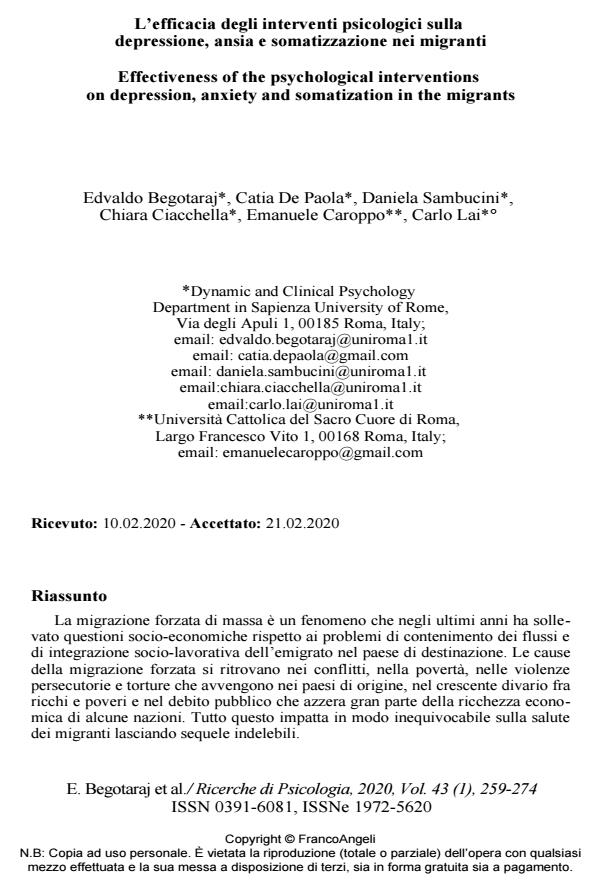L’efficacia degli interventi psicologici sulla depressione, ansia e somatizzazione nei migranti
Titolo Rivista RICERCHE DI PSICOLOGIA
Autori/Curatori Edvaldo Begotaraj, Catia De Paola, Daniela Sambucini, Chiara Ciacchella, Emanuele Caroppo, Carlo Lai
Anno di pubblicazione 2020 Fascicolo 2020/1
Lingua Italiano Numero pagine 16 P. 259-274 Dimensione file 220 KB
DOI 10.3280/RIP2020-001012
Il DOI è il codice a barre della proprietà intellettuale: per saperne di più
clicca qui
Qui sotto puoi vedere in anteprima la prima pagina di questo articolo.
Se questo articolo ti interessa, lo puoi acquistare (e scaricare in formato pdf) seguendo le facili indicazioni per acquistare il download credit. Acquista Download Credits per scaricare questo Articolo in formato PDF

FrancoAngeli è membro della Publishers International Linking Association, Inc (PILA)associazione indipendente e non profit per facilitare (attraverso i servizi tecnologici implementati da CrossRef.org) l’accesso degli studiosi ai contenuti digitali nelle pubblicazioni professionali e scientifiche
La migrazione forzata di massa e un fenomeno che negli ultimi anni ha sollevato questioni socio-economiche rispetto ai problemi di contenimento dei flussi e di integrazione socio-lavorativa dell’emigrato nel paese di destinazione. Le cause della migrazione forzata si ritrovano nei conflitti, nella poverta, nelle violenze persecutorie e torture che avvengono nei paesi di origine, nel crescente divario fra ricchi e poveri e nel debito pubblico che azzera gran parte della ricchezza economica di alcune nazioni. Tutto questo impatta in modo inequivocabile sulla salute dei migranti lasciando sequele indelebili. Negli ultimi anni, infatti, il panorama scientifico ha ampliato il focus di interesse, includendo l’aspetto psicologico del migrante. Le esperienze traumatiche subite dai migranti si hanno luogo in tre momenti: prima, durante e dopo il viaggio migratorio. Tutto questo causa ripercussioni psicologiche che sono tipiche ed inconfondibili, tra la sintomatologia piu rilevante emerge la depressione, l’ansia e la somatizzazione. Negli ultimi anni nasce, dunque, l’esigenza di promuovere il benessere psicologico del migrante nel paese ospitante. L’obiettivo della review era valutare l’efficacia dei trattamenti psicologici maggiormente applicati sui migranti effettuando un’analisi qualitativa della letteratura. La raccolta iniziale dei dati era focalizzata su studi che includevano interventi psicologici e/o farmacologici con una valutazione pre-trattamento e post-trattamento della depressione, dell’ansia e della somatizzazione. La selezione includeva studi di tipo controllato-randomizzato, studi quasi sperimentali e studi osservazionali. La review e stata condotta su 52 studi. I trattamenti psicologici sono stati categorizzati in 5 categorie di trattamento (terapia cognitivo comportamentale, terapia di esposizione narrativa, terapia dinamica, trattamenti psicologici combinati, trattamenti psicologici combinati con trattamenti farmacologici). Per ogni categoria sono stati calcolati i risultati significativi e non significativi in riferimento agli esiti: depressione, ansia e somatizzazione. I risultati qualitativi della review mostravano che le terapie cognitivo comportamentali avevano effetto significativo sulla depressione nel 61% dei casi, sull’ansia nel 50% dei casi, sulla somatizzazione in nessun caso. Le terapie di esposizione narrativa avevano effetti significativi sulla depressione nel 57% dei casi, sulla somatizzazione nel 50% dei casi e sull’ansia in nessun caso. Le terapie dinamiche avevano un effetto significativo sulla depressione nel 50% dei casi, sull’ansia nel 50% cosi come sulla somatizzazione. I trattamenti psicologici combinati avevano un effetto significativo sulla depressione nel 46% dei casi, cosi come sull’ansia e sulla somatizzazione nel 60% dei casi. I trattamenti psicologici combinati con i trattamenti farmacologici avevano un effetto significativo sulla depressione nel 61% dei casi, sull’ansia nel 36% dei casi e sulla somatizzazione nel 39% dei casi. L’osservazione qualitativa, in generale, mostrava una probabilita di avere un significativo effetto post trattamento sull’ansia piu bassa del 50% rispetto alla somatizzazione. Entrando nel dettaglio dei trattamenti sembrava che gli effetti delle terapie cognitivo comportamentali erano dovuti al caso rispetto all’ansia, mentre pareva avessero effetti significativi sia sulla somatizzazione che sulla depressione. Per quanto riguarda le terapie di esposizione narrativa sembrava che la probabilita di avere un effetto significativo sulla depressione era dovuta al caso cosi come per la terapia dinamica e per i trattamenti psicologici combinati, questi tuttavia non sembravano sortire effetti sulla depressione e sull’ansia. Per quanto riguarda i trattamenti psicologici combinati con trattamenti farmacologici si riscontrarono effetti significativi di efficacia sulla depressione ma non su ansia e somatizzazione.
Parole chiave:Migrazione, interventi psicologici, depressione, ansia, somatizzazione.
- Migrazioni e psicologie. Introduzione al Forum Alessandro Antonietti, Antonella Marchetti, in RICERCHE DI PSICOLOGIA 1/2020 pp.13
DOI: 10.3280/RIP2020-001002
Edvaldo Begotaraj, Catia De Paola, Daniela Sambucini, Chiara Ciacchella, Emanuele Caroppo, Carlo Lai, L’efficacia degli interventi psicologici sulla depressione, ansia e somatizzazione nei migranti in "RICERCHE DI PSICOLOGIA " 1/2020, pp 259-274, DOI: 10.3280/RIP2020-001012